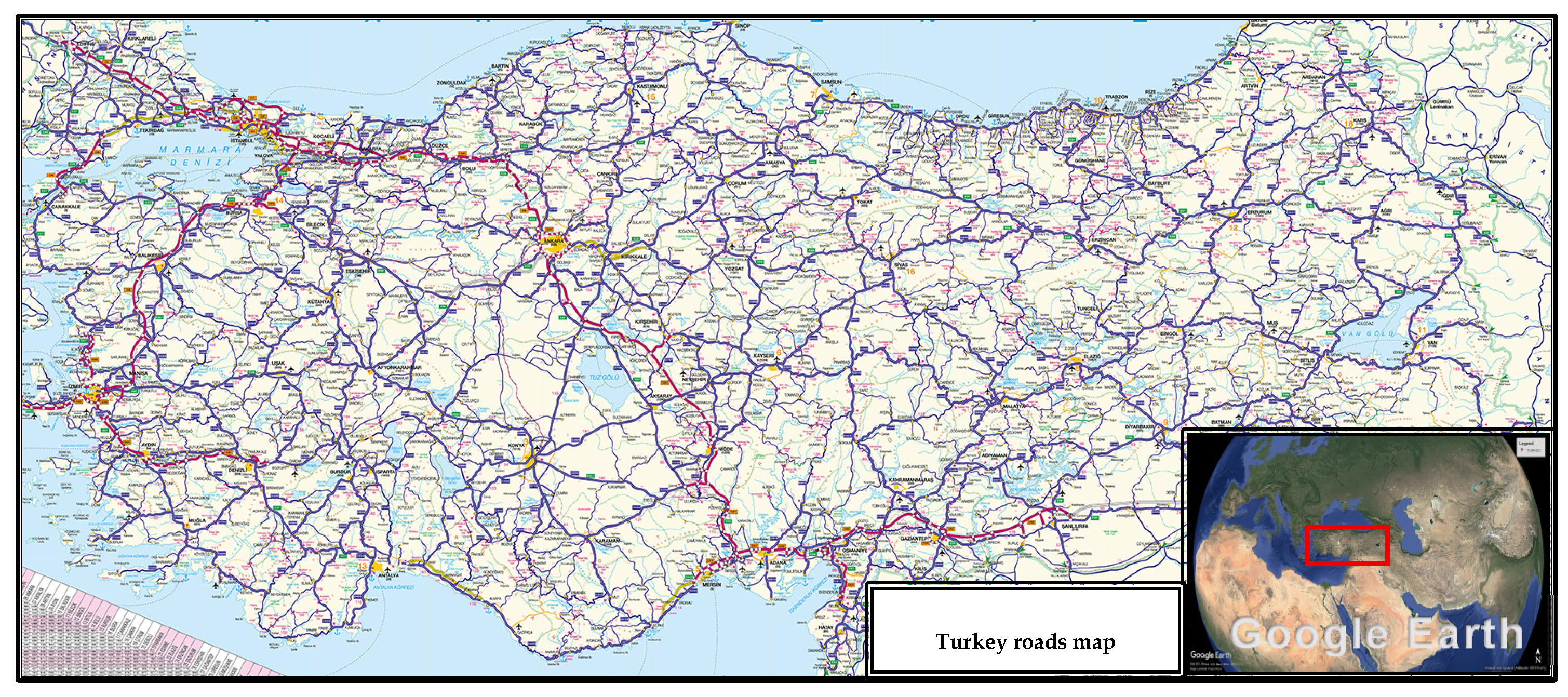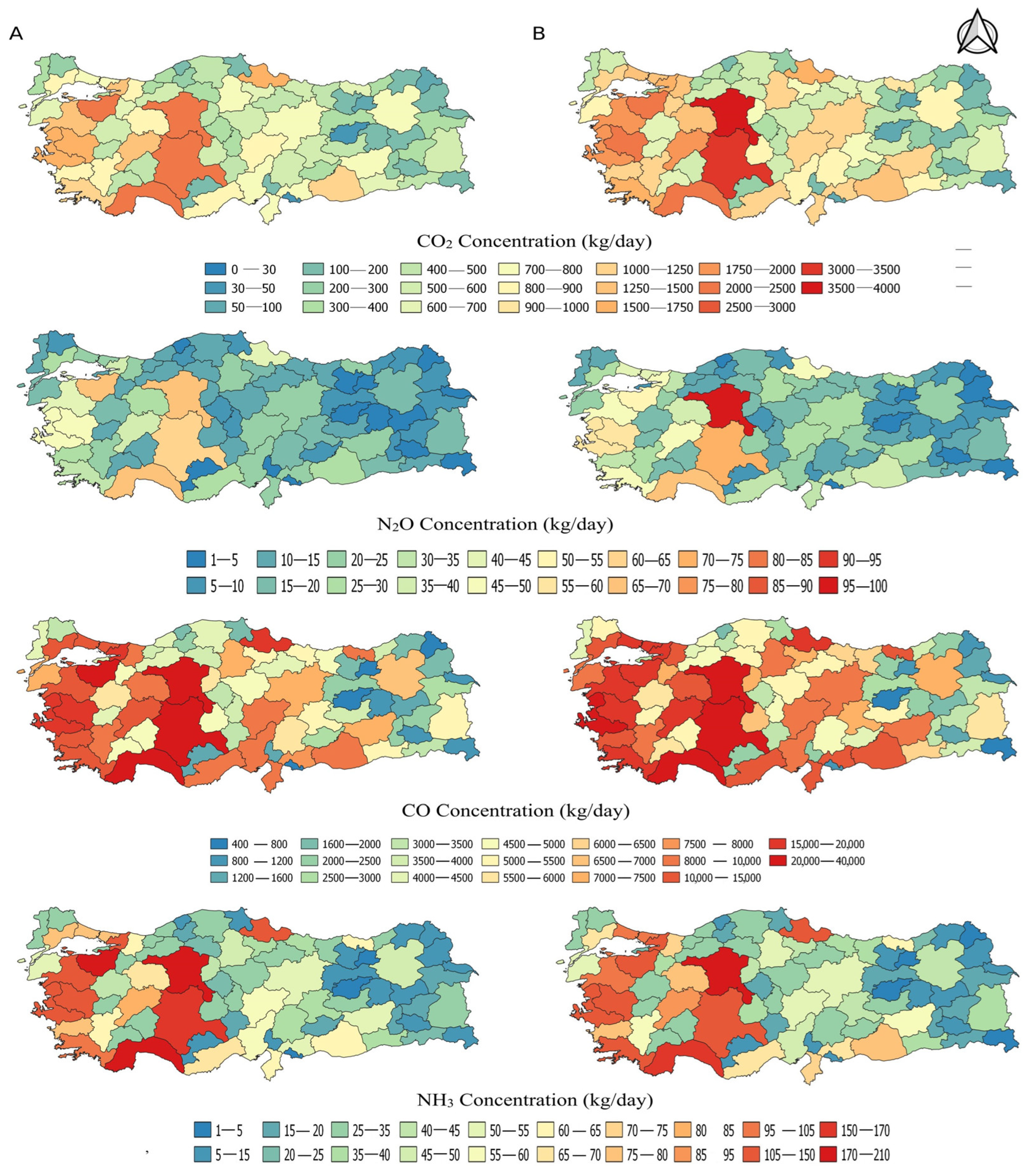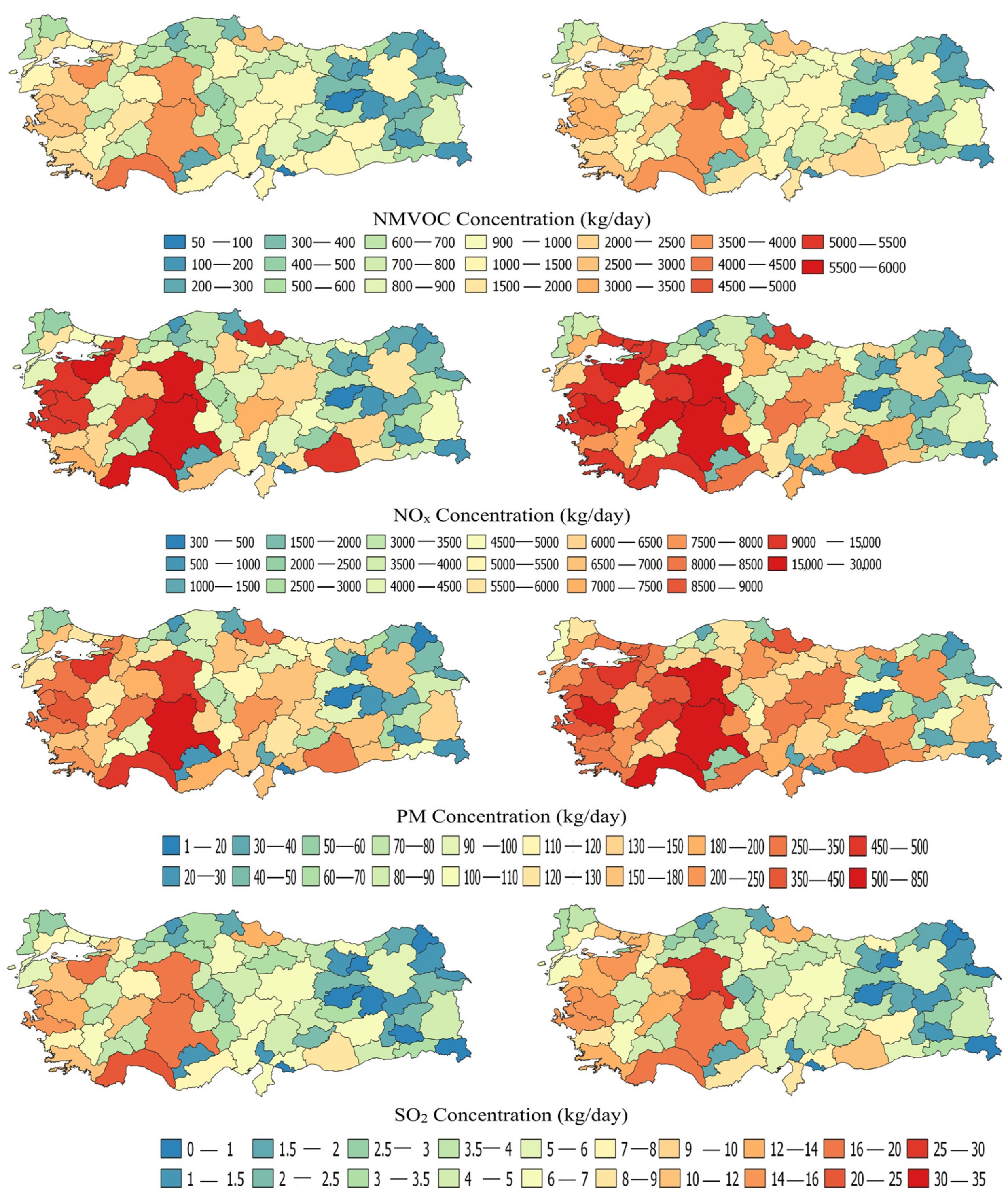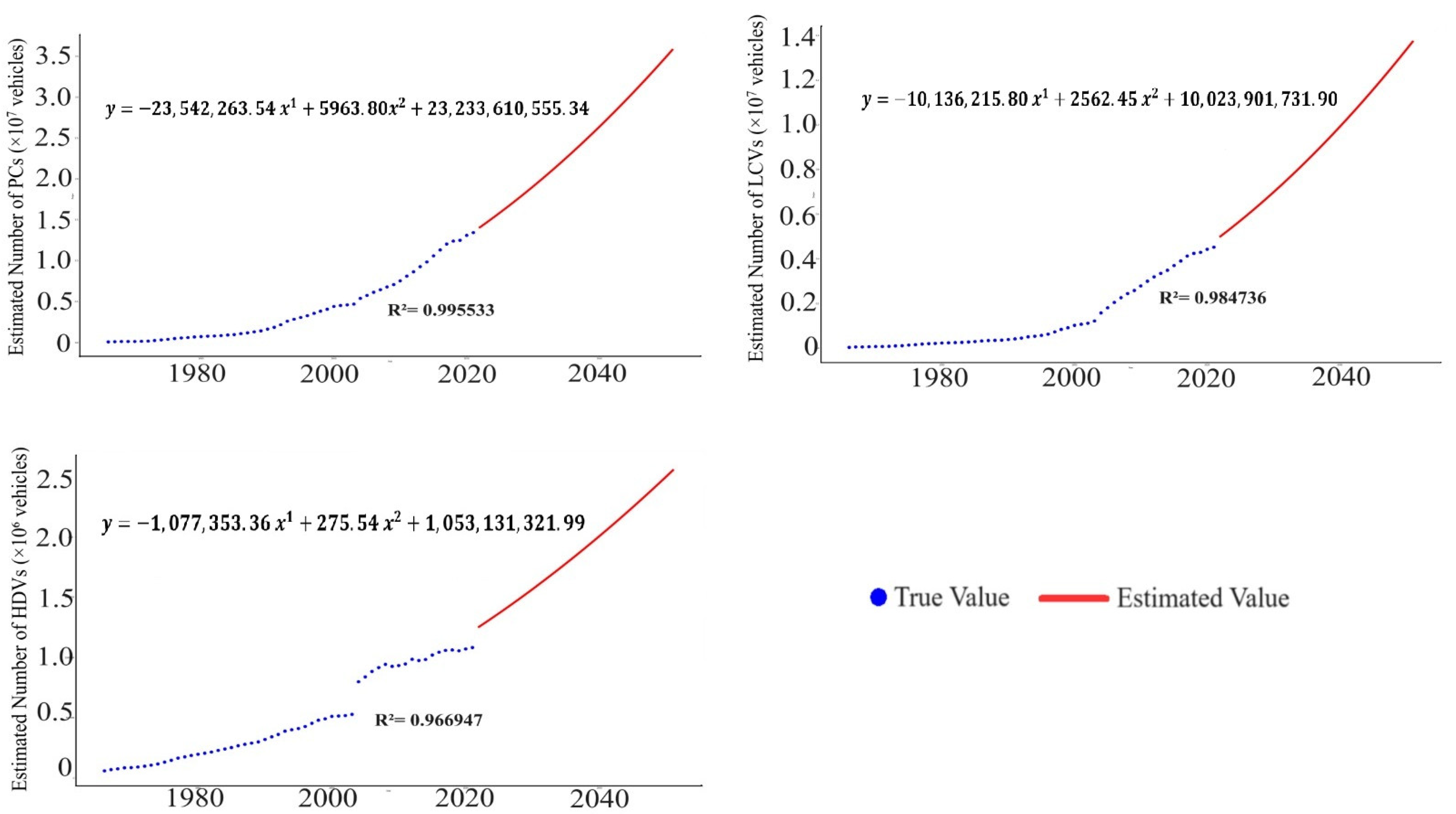Evaluation of Turkey’s Road-Based Greenhouse Gas Inventory and Future Projections
Abstract
1. Introduction
2. Materials and Methods
2.1. Study Area
2.2. Emission Calculations
2.3. Future Predictions
2.4. Polynomial Regression
2.5. Distribution Maps
3. Results
3.1. Greenhouse Gas Emission Calculations from State Roads
- The daily CO2 ranged from 47.8 to 2429 kg in 2010 and increased from 98.74 to 3024.8 kg in 2020. In 2010, Konya province had the highest recorded CO2 emissions. In contrast, Ankara province had the highest values reported in 2020.
- The daily N2O in 2010 ranged from 1.21 to 69.53 kg/day, whereas in 2020, it ranged from 1.72 to 97.94 kg/day. Emissions were significantly elevated, particularly in central Turkey. In 2010, the province with the highest emissions was Bursa. In 2020, it was Antalya.
- The daily CO ranged from 406.06 to 26,895.91 kg/day in 2010 and from 599.12 to 34,543.22 kg/day in 2020. In 2010, Antalya province had the highest recorded emission amount. In 2020, it was Ankara.
- NH3 was calculated in the range of 2.75–196.82 kg/day in 2010 and 3.63–209.54 kg/day in 2020. The highest emission quantity was calculated in Antalya in 2010 and in Ankara in 2020.
- When NMVOC levels were examined, the values ranged between 64.83 and 4030.7 kg/day in 2010. Antalya has the highest calculated emissions. In 2020, there was a change between 94.42 and 5436.84 kg/day, and the highest emission was calculated in Ankara.
- NOX amounts were calculated as 330.67–19,470.02 kg/day and 446.55–25,733.49 kg/day for 2010 and 2020, respectively. The calculated maximum emissions were for Konya and Ankara, respectively.
- The daily quantity of PM10 was calculated to be 9.20–551.12 kg in 2010 and 15.51–835.51 kg in 2020. The provinces of Konya and Ankara had the highest emission quantities for 2010 and 2020, respectively.
- In Turkey, the amount of SO2 emissions was calculated to be 0.35–20.19 kg/day in 2010 and 0.44–25.30 kg/day in 2020. Antalya (in 2010) and Ankara (in 2020) were determined to have the maximum emission quantities.
3.2. Emission Estimates for Future Years
4. Conclusions
Author Contributions
Funding
Institutional Review Board Statement
Informed Consent Statement
Data Availability Statement
Conflicts of Interest
Abbreviations
| CO2 | carbon dioxide |
| N2O | nitrous oxide |
| NH3 | ammonia |
| NOX | nitrogen oxide |
| SO2 | sulfur dioxide |
| CO | carbon monoxide |
| NMVOC | non-methane volatile organic compounds |
| PM | particulate matter |
| IPCC | intergovernmental panel on climate change |
| NDCs | determined contributions |
| GHG | greenhouse gas |
| LPG | liquid petroleum gas |
| EMEP/EEA | European Monitoring and Evaluation Programme/European Environment Agency |
| GDH | general directorate of highways |
| GIS | geographic information system |
| TurkStat | Turkish statistical institute |
| AADT | annual average daily traffic |
| PC | personal cars |
| LCV | light commercial vehicles |
| HDV | heavy duty vehicles |
| SE | standard error |
| RSE | relative standard error |
| ABS | Australian Bureau of statistics |
| RMSE | root mean square error |
| MAE | mean absolute error |
References
- EEA. European Environment Agency. About Climate Change. 2016. Copenhagen, Denmark. Available online: https://www.eea.europa.eu/tr/themes/climate/about-climate-change (accessed on 31 January 2019).
- IPCC Fourth Assessment Report: Climate Change 2007: Working Group I: The Physical Science Basis. Geneva, Switzerland. Available online: https://archive.ipcc.ch/publications_and_data/ar4/wg1/en/spmsspm-direct-observations.html (accessed on 3 June 2025).
- Jaroszweski, D.; Chapman, L.; Petts, J. Assessing the potential impact of climate change on transportation: The need for an interdisciplinary approach. J. Transp. Geogr. 2010, 18, 331–335. [Google Scholar] [CrossRef]
- Carlsson Kanyama, A.; Carlsson Kanyama, K.; Wester, M.; Snickare, L.; Söderberg, I.L. Climate change mitigation efforts among transportation and manufacturing companies: The current state of efforts in Sweden according to available documentation. J. Clean. Prod. 2018, 196, 588–593. [Google Scholar] [CrossRef]
- IPCC Climate Change 2021 The Physical Science Basis, Working Group I Contribution to the Sixth Assessment Report of the Intergovernmental Panel on Climate Change. Geneva, Switzerland. Available online: https://www.ipcc.ch/report/ar6/wg1/downloads/report/IPCC_AR6_WGI_FullReport.pdf (accessed on 3 June 2025).
- DCC, Directorate of Climate Change, Repuclic of Turkey Ministry of Environment, Urbanization and Climate Change. Republic of Türkiye Updated First Nationally Determined Contribution. 2024. Ankara, Turkey. Available online: https://unfccc.int/sites/default/files/NDC/2023-04/T%C3%9CRK%C4%B0YE_UPDATED%201st%20NDC_EN.pdf (accessed on 30 January 2024).
- DCC. Directorate of Climate Change, Repuclic of Turkey Ministry of Environment, Urbanization and Climate Change. Paris Agreement. 2024. Ankara, Turkey. Available online: https://iklim.gov.tr/en/paris-agreement-i-117 (accessed on 30 January 2024).
- EEA. European Environment Agency. High Time to Shift Gear in Transport Sector. 2023. Copenhagen, Denmark. Available online: https://www.eea.europa.eu/signals-archived/signals-2022/articles/high-time-to-shift-gear (accessed on 29 August 2023).
- Transport and Environment Report 2021, European Environmental Agency, EEA Report 02/2022. Copenhagen, Denmark. Available online: https://www.eea.europa.eu/en/analysis/publications/transport-and-environment-report-2021 (accessed on 4 June 2025).
- IPCC. Intergovernmental Panel on Climate Change. IPCC Sixth Assessment Report. Chapter 10: Transport. 2021. Geneva, Switzerland. Available online: https://www.ipcc.ch/report/ar6/wg3/chapter/chapter-10/ (accessed on 30 January 2021).
- IEA. International Energy Agency. Tracking Transport 2020. 2021. Paris, France. Available online: https://www.iea.org/energy-system/transport (accessed on 30 January 2021).
- RTMEUCC. Repuclic of Turkey Ministry of Environment, Urbanization and Climate Change. Greenhouse Gas Emission by Transportation Type. 2024. Turkey, Ankara. Available online: https://cevreselgostergeler.csb.gov.tr/%20ulastirma-turune-gore-seragazi-emisyonu-i-85790 (accessed on 30 January 2024).
- Ku, A.; Kammen, D.M.; Castellanos, S. A quantitative, equitable framework for urban transportation electrification: Oakland, California as a mobility model of climate justice. Sustain. Cities Soc. 2021, 74, 103179. [Google Scholar] [CrossRef]
- Afifa; Arshad, K.; Hussain, N.; Ashraf, M.H.; Saleem, M.Z. Air pollution and climate change as grand challenges to sustainability. Sci. Total Environ. 2024, 928, 172370. [Google Scholar] [CrossRef] [PubMed]
- Republic of Turkey Ministry of Environment, Urbanization and Climate Change. 2024. Türkiye 2053 Long Term Climate Strategy. Turkey, Ankara. Available online: https://iklim.gov.tr/db/turkce/icerikler/files/T%C3%BCrkiye’nin%20Uzun%20D%C3%B6nemli%20%C4%B0klim%20Stratejisi.pdf (accessed on 2 June 2025).
- Yılmaz, M.; Toros, H.; İncecik, S.; Öztürk, Z.; Kirkil, G.; Öztaş, D.; Akçay, M.; Dinç, U.; Gültekin, M.; Beba, H.E.; et al. Evaluation of Dilovası Air Pollution in Terms of Traffic Emissions. Natl. J. Environ. Sci. Res. 2020, 3, 43–51. Available online: https://dergipark.org.tr/tr/pub/ucbad/issue/54360/738990 (accessed on 5 June 2025).
- Franzò, S.; Nasca, A. The environmental impact of electric vehicles: A comparative LCA-based evaluation framework and its application to the Italian context. In Proceedings of the Fifteenth International Conference on Ecological Vehicles and Renewable Energies, Monte-Carlo, Monaco, 10–12 September 2020; pp. 10–13. [Google Scholar] [CrossRef]
- Doğan Güzel, T.; Alp, K. Modeling of greenhouse gas emissions from the transportation sector in Istanbul by 2050. Atmos. Pollut. Res. 2020, 11, 2190–2201. [Google Scholar] [CrossRef]
- Yakın, A.; Behçet, R. Emission Inventory of Air Pollution Based on Traffic in Van Province. Iğdır Univ. Sci. Inst. J. 2019, 9, 1567–1573. [Google Scholar] [CrossRef]
- Civelekoğlu, G.; Bıyık, Y. Investigation of Carbon Footprint Change Originated from Transportation Sector. Bilge Int. J. Sci. Technol. Res. 2018, 2, 157–166. [Google Scholar] [CrossRef]
- Cuci, Y.; Polat, E.E. Determination of Traffic-Related Air Pollution in Gaziantep. Kahramanmaras Sutcu Imam Univ. J. Eng. Sci. 2015, 18, 1–11. [Google Scholar] [CrossRef]
- Anderson, M.L. Subways, Strikes, and Slowdowns: The Impacts of Public Transit on Traffic Congestion. Am. Econ. Rev. 2014, 104, 2763–2796. [Google Scholar] [CrossRef]
- Chen, Y.; Whalley, A. Green Infrastructure: The Effects of Urban Rail Transit on Air Quality. Am. Econ. J. Econ. Policy 2012, 4, 58–97. [Google Scholar] [CrossRef]
- Yang, C.; McCollum, D.; McCarthy, R.; Leighty, W. Meeting an 80% reduction in greenhouse gas emissions from transportation by 2050: A case study in California. Transp. Res. Part D: Transp. Environ. 2009, 14, 147–156. [Google Scholar] [CrossRef]
- MD. Mınıstry of Development. Eleventh Development Plan. 2018. Ankara, Turkey. Available online: https://www.guvenlitrafik.gov.tr/kurumlar/guvenlitrafik.gov.tr/Karayolu_Trafik_Guvenligi_Calisma_Grubu_Raporu.pdf (accessed on 30 January 2024).
- Turkish Statistical Institute (TurkStat), TP. Turkey Population. 2023. Ankara, Turkey. Available online: https://www.nufusu.com/ (accessed on 30 January 2024).
- GDH. General Directorate of Highways. General Directorate of Highways from Past to Present. 2023. Ankara, Turkey. Available online: https://www.kgm.gov.tr/Sayfalar/KGM/SiteTr/Root/default.aspx (accessed on 30 January 2024).
- GDH. General Directorate of Highways. Maps. 2021. Ankara, Turkey. Available online: https://www.kgm.gov.tr/SiteCollectionImages/KGMimages/Haritalar/turistik.jpg (accessed on 30 January 2022).
- TurkStat. Turkish Statistical Enstitute. Motor Vehicles. January 2023. Ankara, Turkey. Available online: https://data.tuik.gov.tr/Bulten/Index?p=Motorlu-Kara-Ta%C5%9F%C4%B1tlar%C4%B1-Ocak-2023-49433&dil=1 (accessed on 30 January 2024).
- RTMEUCC. Repuclic of Turkey Ministry of Environment. Urbanization and Climate Change. Number of Motorized Land Vehicles. 2024. Ankara, Turkey. Available online: https://cevreselgostergeler.csb.gov.tr/motorlu-kara-tasiti-sayisi-i-85797 (accessed on 30 January 2024).
- GDH. General Directorate of Highways, Ministry of Transport and Infrastructure. Traffic and Transportation Information. 2021. Ankara, Turkey. Available online: https://www.kgm.gov.tr/Sayfalar/KGM/SiteTr/Trafik/TrafikveUlasimBilgileri.aspx (accessed on 31 January 2022).
- Seo, J.; Park, J.; Park, J.; Park, S. Emission factor development for light-duty vehicles based on real-world emissions using emission map-based simulation. Environ. Pollut. 2021, 270, 116081. [Google Scholar] [CrossRef] [PubMed]
- EMEP/EEA. Europen Environment Agency. Air Pollutant Emission Inventory Guidebook. 2023. Copenhagen, Denmark. Available online: https://www.eea.europa.eu/en/analysis/publications/emep-eea-guidebook-2023 (accessed on 2 June 2025).
- EMEP/EEA. European Environment Agency. Air Pollutant Emission Inventory Guidebook 2019. Publications Office of the European Union. Copenhagen, Denmark. Available online: https://www.eea.europa.eu/publications/emep-eea-guidebook-2019/part-b-sectoral-guidance-chapters/1-energy/1-a-combustion/1-a-3-b-i/view (accessed on 30 January 2021).
- Kim, R.; Jayanti, R.P.; Lee, H.; Kim, H.K.; Kang, J.; Park, N.; Kim, J.; Oh, J.Y.; Kim, H.W.; Lee, H.; et al. Development of a population pharmacokinetic model of pyrazinamide to guide personalized therapy: Impacts of geriatric and diabetes mellitus on clearance. Front. Pharmacol. 2023, 14, 1116226. [Google Scholar] [CrossRef]
- McHugh, M.L. Standard error: Meaning and interpretation. Biochem. Medica (Zagreb) 2008, 18, 7–13. [Google Scholar] [CrossRef]
- Altman, D.G.; Bland, J.M. Standard deviations and standard errors. BMJ 2005, 331, 903. [Google Scholar] [CrossRef]
- Australian Bureau of Statistics, ABS. November 19, 2021. Confidentiality and Relative Standard Error. Canberra, ACT, Australia. Available online: https://www.abs.gov.au/statistics/microdata-tablebuilder/tablebuilder/confidentiality-and-relative-standard-error (accessed on 13 June 2025).
- Sarkodie, K.; Fergusson-Rees, A.; Abdulkadir, M.; Yaw Asiedu, N. Gas-liquid flow regime identification via a non-intrusive optical sensor combined with polynomial regression and linear discriminant analysis. Ann. Nucl. Energy 2023, 180, 109424. [Google Scholar] [CrossRef]
- Shi, M.; Hu, W.; Li, M.; Zhang, J.; Song, X.; Sun, W. Ensemble regression based on polynomial regression-based decision tree and its application in the in-situ data of tunnel boring machine. Mech. Syst. Signal Process. 2023, 188, 110022. [Google Scholar] [CrossRef]
- Singh, K.P.; Gupta, S.; Kumar, A.; Shukla, S.P. Linear and nonlinear modeling approaches for urban air quality prediction. Sci. Total Environ. 2012, 426, 244–255. [Google Scholar] [CrossRef]
- Iqbal, A.M. Application of Regression Techniques with their Advantages and Disadvantages. Elektron. Mag. 2020, 4, 11. Available online: https://www.researchgate.net/publication/354921553_Application_of_Regression_Techniques_with_their_Advantages_and_Disadvantages (accessed on 30 January 2024).
- Shanock, L.R.; Baran, B.E.; Gentry, W.A.; Pattison, S.C.; Heggestad, E.D. Polynomial Regression with Response Surface Analysis: A Powerful Approach for Examining Moderation and Overcoming Limitations of Difference Scores. J. Bus. Psychol. 2010, 25, 543–554. [Google Scholar] [CrossRef]
- Ajona, M.; Vasanthi, P.; Vijayan, D.S. Application of multiple linear and polynomial regression in the sustainable biodegradation process of crude oil. Sustain. Energy Technol. Assess. 2022, 54, 102797. [Google Scholar] [CrossRef]
- Aslan, V.; Eryilmaz, T. Polynomial regression method for optimization of biodiesel production from black mustard (Brassica nigra L.) seed oil using methanol, ethanol, NaOH, and KOH. Energy 2020, 209, 118386. [Google Scholar] [CrossRef]
- Chai, T.; Draxler, R.R. Root mean square error (RMSE) or mean absolute error (MAE)?—Arguments against avoiding RMSE in the literature. Geosci. Model Dev. 2014, 7, 1247–1250. [Google Scholar] [CrossRef]
- Mbandi, A.M.; Malley, C.S.; Schwela, D.; Vallack, H.; Emberson, L.; Ashmore, M.R. Assessment of the impact of road transport policies on air pollution and greenhouse gas emissions in Kenya. Energy Strategy Rev. 2023, 49, 101120. [Google Scholar] [CrossRef]
- Türkay, M. Karayolu Ulaşımından Kaynaklanan sera Gazı Emisyonunun (Karbon Ayak Izinin) Hesaplanması: Eskişehir ili Örneği. Master’s Thesis, Cumhuriyet University, Sivas, Turkey, 2018. Available online: https://tez.yok.gov.tr/UlusalTezMerkezi/tezDetay.jsp?id=h_oND-zFpEPniNFRp8KCtw&no=z7z8rI4ek1lfdPBfXH2JGQ (accessed on 30 January 2024).
- EP. European Parliament. EU Ban on the Sale of New Petrol and Diesel Cars from 2035 Explained. 2022. Brussels, Belgium. Available online: https://www.europarl.europa.eu/topics/en (accessed on 31 January 2024).
- Çalik, Ö.N.; Doğruparmak, Ş.Ç. Effect of COVID-19 lockdown on ambient air quality. Clean Air Soil Water 2024, 52, 2300101. [Google Scholar] [CrossRef]
- Karababa, A.O.; Atlı, B.; Çağlayan, Ç.; Varol, G.; Ersoy, G.; Gacal, F.; Etiler, N.; Özfırat, P.; Ayta, S. Black Report. 2020. Right to Clean Air Platform publications. Istanbul, Turkey. Available online: https://www.temizhavahakki.com/wp-content/uploads/2020/09/Kara-Rapor-2020-Son27082020.pdf (accessed on 10 January 2024).
- Tosun, K.E. The analysis of compact city model in the process of sustainable urban development. Dokuz Eylul Univ. J. Grad. Sch. Soc. Sci. 2013, 15, 103–120. [Google Scholar]
- İrhami, E.A.; Farizal, F. Forecasting the number of vehicles in Indonesia using auto regressive integrative moving average (ARIMA) method. J. Phys. Conf. Ser. 2021, 1845, 012024. [Google Scholar] [CrossRef]
- Sekuła, P.; Marković, N.; Vander Laan, Z.; Farokhi Sadabadi, K. Estimating historical hourly traffic volumes via machine learning and vehicle probe data: A Maryland case study. Transp. Res. Part C Emerg. Technol. 2018, 97, 147–158. [Google Scholar] [CrossRef]
- Sayed, A.S.; Abdel-Hamid, Y.; Hefny, H.A. Artificial intelligence-based traffic flow prediction: A comprehensive review. J. Electr. Syst. Inf. Technol. 2023, 10, 13. [Google Scholar] [CrossRef]
- Alhindawi, R.; Abu Nahleh, Y.; Kumar, A.; Shiwakoti, N. Projection of greenhouse gas emissions for the road transport sector based on multivariate regression and the double exponential smoothing model. Sustainability 2020, 12, 9152. [Google Scholar] [CrossRef]
- RTMEUCC. Repuclic of Turkey Ministry of Environment, Urbanization and Climate Change. Ingested Areas and Carbon Sequestration. 2024. Ankara, Turkey. Available online: https://cevreselgostergeler.csb.gov.tr/yutak-alanlar-ve-karbon-tutumlari-i-85723 (accessed on 31 January 2024).
- Demirtürk, D. Studies towards reducing greenhouse gas effect in sustainable transportation. J. Eng. Sci. Des. 2021, 9, 1080–1092. [Google Scholar] [CrossRef]
- Chen, J.; Zhao, F.; Liu, Z.; Ou, X.; Hao, H. Greenhouse gas emissions from road construction in China: A province-level analysis. J. Clean. Prod. 2017, 168, 1039–1047. [Google Scholar] [CrossRef]
- Habib, Y.; Xia, E.; Hashmi, S.H.; Ahmed, Z. The nexus between road transport intensity and road-related CO2 emissions in G20 countries: An advanced panel estimation. Environ. Sci. Pollut. Res. 2021, 28, 58405–58425. [Google Scholar] [CrossRef]







| Emission | Automobile g/kg | HDV g/kg | LCV g/kg | ||
|---|---|---|---|---|---|
| Gasoline | Diesel | LPG | Gasoline | Diesel | |
| CO | 84.7 | 3.33 | 84.7 | 7.58 | 7.4 |
| CO2 | 3.18 | 3.14 | 3.017 | 3.14 | 3.14 |
| SO2 | 0.08 | 0.016 | 0 | 0.016 | 0.016 |
| PM | 0.03 | 1.1 | 0 | 0.94 | 1.52 |
| NOx | 8.73 | 12.96 | 15.2 | 33.37 | 14.91 |
| NMVOCs | 10.05 | 0.7 | 13.64 | 1.92 | 1.54 |
| N2O | 0.206 | 0.087 | 0.089 | 0.051 | 0.056 |
| NH3 | 1.106 | 0.065 | 0.08 | 0.013 | 0.038 |
| Vehicle Category | Fuel | Characteristic Fuel Consumption (g/km) |
|---|---|---|
| Automobile | Gasoline | 70 |
| Diesel | 60 | |
| LPG | 57.5 | |
| E85 | 86.5 | |
| CNG | 62.6 | |
| LCV | Gasoline | 100 |
| Diesel | 80 | |
| HDV | Diesel | 240 |
| CNG | 500 |
| 2010 | 2011 | 2012 | 2013 | 2014 | 2015 | 2016 | 2017 | 2018 | 2019 | 2020 | Total | σ | RSE % | Increase % | ||
|---|---|---|---|---|---|---|---|---|---|---|---|---|---|---|---|---|
| CO2 | PC | 20,074 | 21,499 | 22,444 | 23,066 | 25,735 | 28,765 | 29,559 | 32,605 | 33,073 | 33,677 | 31,075 | 301,572 | 5033.02 | 5.54 | 54.8 |
| LCV | 2595 | 2757 | 2755 | 2639 | 2716 | 2824 | 2866 | 4211 | 5176 | 5192 | 4870 | 38,601 | 1104.28 | 9.49 | 87.6 | |
| HDV | 29,125 | 31,778 | 32,255 | 33,508 | 34,346 | 36,095 | 35,949 | 36,263 | 32,342 | 31,440 | 31,202 | 364,303 | 2323.82 | 2.12 | 7.1 | |
| Total | 51,794 | 56,034 | 57,454 | 59,213 | 62,797 | 67,684 | 68,374 | 73,079 | 70,591 | 70,309 | 67,147 | 704,476 | 6985.10 | 3.29 | 29.6 | |
| N2O | PC | 927 | 952 | 962 | 963 | 1052 | 1159 | 1180 | 1288 | 1293 | 1306 | 1208 | 12,289 | 150.08 | 45.50 | 30.3 |
| LCV | 46 | 49 | 49 | 47 | 48 | 50 | 51 | 75 | 92 | 92 | 86 | 687 | 19.56 | 45.78 | 85.9 | |
| HDV | 473 | 516 | 524 | 544 | 558 | 586 | 584 | 589 | 525 | 506 | 502 | 5907 | 38.52 | 45.47 | 6.1 | |
| Total | 1446 | 1517 | 1535 | 1554 | 1658 | 1795 | 1815 | 1952 | 1911 | 1903 | 1796 | 18,883 | 180.55 | 45.48 | 24.2 | |
| NH3 | PC | 3621 | 3512 | 3384 | 3248 | 3427 | 3684 | 3692 | 3894 | 3897 | 3878 | 3604 | 39,840 | 216.99 | 1.81 | -0.4 |
| LCV | 31 | 33 | 33 | 32 | 33 | 34 | 35 | 51 | 63 | 62 | 58 | 466 | 13.24 | 9.45 | 85.9 | |
| HDV | 121 | 132 | 134 | 139 | 142 | 149 | 149 | 150 | 134 | 129 | 128 | 1506 | 9.64 | 2.12 | 6.1 | |
| Total | 3773 | 3676 | 3551 | 3419 | 3602 | 3867 | 3876 | 4095 | 4094 | 4069 | 3791 | 41,812 | 227.73 | 1.81 | 0.5 | |
| NOX | PC | 75,685 | 82,983 | 88,058 | 91,549 | 102,979 | 115,481 | 118,783 | 131,273 | 133,557 | 136,143 | 125,361 | 1,201,852 | 21,924.09 | 6.05 | 65.6 |
| LCV | 12,323 | 13,093 | 13,081 | 12,529 | 12,896 | 13,412 | 13,608 | 19,996 | 24,578 | 24,419 | 22,904 | 182,840 | 5181.09 | 9.40 | 85.9 | |
| HDV | 309,519 | 337,716 | 342,788 | 356,105 | 365,007 | 383,594 | 382,044 | 385,381 | 343,707 | 330,964 | 328,461 | 3,865,286 | 25,211.01 | 2.16 | 6.1 | |
| Total | 397,527 | 433,792 | 443,927 | 460,183 | 480,883 | 512,486 | 514,435 | 536,650 | 501,842 | 491,526 | 476,726 | 5,249,977 | 40,768.56 | 2.58 | 19.9 | |
| PM | PC | 1333 | 1669 | 1948 | 2212 | 2672 | 3229 | 3518 | 4080 | 4306 | 4535 | 4212 | 33,714 | 1155.74 | 11.37 | 216.0 |
| LCV | 1256 | 1335 | 1334 | 1277 | 1315 | 1367 | 1387 | 2038 | 2506 | 2489 | 2335 | 18,640 | 528.17 | 9.40 | 85.9 | |
| HDV | 8719 | 9513 | 9656 | 10,031 | 10,282 | 10,805 | 10,762 | 10,856 | 9682 | 9323 | 9252 | 108,881 | 710.17 | 2.16 | 6.1 | |
| Total | 11,308 | 12,517 | 12,938 | 13,520 | 14,269 | 15,402 | 15,668 | 16,975 | 16,493 | 16,347 | 15,799 | 161,235 | 1862.13 | 3.83 | 39.7 | |
| SO2 | PC | 262 | 255 | 248 | 240 | 256 | 279 | 282 | 306 | 303 | 304 | 283 | 3018 | 23.65 | 2.60 | 8.3 |
| LCV | 13 | 14 | 14 | 13 | 14 | 14 | 15 | 21 | 26 | 26 | 25 | 196 | 5.55 | 9.44 | 85.9 | |
| HDV | 148 | 162 | 164 | 171 | 175 | 184 | 183 | 185 | 165 | 159 | 157 | 1853 | 12.20 | 2.18 | 6.1 | |
| Total | 423 | 431 | 426 | 424 | 445 | 477 | 480 | 512 | 494 | 489 | 465 | 5068 | 32.09 | 2.10 | 9.9 | |
| CO | PC | 453,721 | 468,080 | 473,381 | 470,859 | 509,985 | 551,676 | 551,665 | 593,340 | 589,312 | 588,222 | 540,609 | 5,790,849 | 53,468.35 | 3.06 | 19.2 |
| LCV | 6116 | 6498 | 6492 | 6218 | 6401 | 6656 | 6754 | 9924 | 12,199 | 12,120 | 11,367 | 90,746 | 2571.58 | 9.40 | 85.9 | |
| HDV | 70,307 | 76,712 | 77,864 | 80,889 | 82,911 | 87,133 | 86,781 | 87,539 | 78,073 | 75,178 | 74,610 | 878,000 | 5726.63 | 2.16 | 6.1 | |
| Total | 530,144 | 551,290 | 557,737 | 557,966 | 599,297 | 645,466 | 645,200 | 690,803 | 679,584 | 675,520 | 626,587 | 6,759,595 | 57,956.62 | 2.84 | 18.2 | |
| NMVOC | PC | 62,327 | 65,186 | 66,602 | 66,754 | 72,717 | 78,861 | 78,929 | 85,036 | 84,670 | 84,638 | 77,661 | 823,380 | 8514.47 | 3.43 | 24.6 |
| LCV | 1273 | 1352 | 1351 | 1294 | 1332 | 1385 | 1406 | 2065 | 2539 | 2522 | 2366 | 18,885 | 535.20 | 9.40 | 85.9 | |
| HDV | 17,809 | 19,431 | 19,723 | 20,489 | 21,001 | 22,071 | 21,982 | 22,174 | 19,776 | 19,043 | 18,899 | 222,396 | 1450.56 | 2.16 | 6.1 | |
| Total | 81,408 | 85,969 | 87,676 | 88,537 | 95,050 | 102,317 | 102,316 | 109,275 | 106,984 | 106,203 | 98,925 | 1,064,660 | 9601.79 | 2.99 | 21.5 |
Disclaimer/Publisher’s Note: The statements, opinions and data contained in all publications are solely those of the individual author(s) and contributor(s) and not of MDPI and/or the editor(s). MDPI and/or the editor(s) disclaim responsibility for any injury to people or property resulting from any ideas, methods, instructions or products referred to in the content. |
© 2025 by the authors. Licensee MDPI, Basel, Switzerland. This article is an open access article distributed under the terms and conditions of the Creative Commons Attribution (CC BY) license (https://creativecommons.org/licenses/by/4.0/).
Share and Cite
Çetin Doğruparmak, Ş.; Demirarslan, K.O.; Çavuşoğlu, S.V. Evaluation of Turkey’s Road-Based Greenhouse Gas Inventory and Future Projections. Appl. Sci. 2025, 15, 7007. https://doi.org/10.3390/app15137007
Çetin Doğruparmak Ş, Demirarslan KO, Çavuşoğlu SV. Evaluation of Turkey’s Road-Based Greenhouse Gas Inventory and Future Projections. Applied Sciences. 2025; 15(13):7007. https://doi.org/10.3390/app15137007
Chicago/Turabian StyleÇetin Doğruparmak, Şenay, Kazım Onur Demirarslan, and Samet Volkan Çavuşoğlu. 2025. "Evaluation of Turkey’s Road-Based Greenhouse Gas Inventory and Future Projections" Applied Sciences 15, no. 13: 7007. https://doi.org/10.3390/app15137007
APA StyleÇetin Doğruparmak, Ş., Demirarslan, K. O., & Çavuşoğlu, S. V. (2025). Evaluation of Turkey’s Road-Based Greenhouse Gas Inventory and Future Projections. Applied Sciences, 15(13), 7007. https://doi.org/10.3390/app15137007






